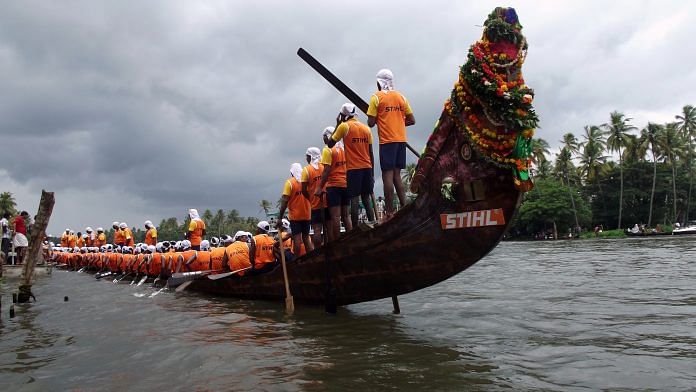Tourism, an employer of lakhs and one of the state’s biggest sources of income, will take time to recover from the recent floods.
Kuttanad (Alappuzha): The long, intricately carved snake boats of Kerala were all set for the ‘Olympics of the backwaters’ when a furious monsoon unleashed a wave of destruction on the state.
Now they lie forsaken, many of them damaged, an epitome of the forlorn tourist season the travel paradise stares at after being battered by its worst floods in a century.
The floods struck when the state was on the precipice of its prime tourist season, a crushing blow as Kerala tries to get back on its feet given that tourism is the state’s second strongest source of income and employs lakhs.
Tourism accounts for 10 per cent of the gross state domestic product (GSDP), earning an estimated Rs 33,000 crore in annual revenue.
With nearly 80 per cent of the tourist bookings cancelled soon after the floods, the government estimates that Kerala’s overall growth rate is set for a fall, from a projected eight per cent to seven.
Also read: Centre’s decision to refuse flood aid from other countries unfortunate: Kerala minister
Kerala finance minister Dr Thomas Isaac agreed that the floods will have a huge impact on the revenue of the state. “This is one of the worst floods in Kerala’s history and the destruction is very widespread. But there is a lot of interest and solidarity with Kerala,” he said.
“I just hope the tourism department is able to bounce back as it provides employment to lakhs of people. Our rate of growth annually is pegged at eight per cent, but now I think we will drop to seven per cent,” Isaac added.
In debt
The Nehru Trophy Boat Race was to start on 11 August, setting the stage for a new Indian Premier League-style championship for the sport, the Champions Boat League.
For the boat race, among the highlights of the harvest festival of Onam, each of the boat clubs had shelled out close to Rs 50 lakh for the training of participants, the maintenance of boats, and other preparations.
Today, they find themselves at a loss because the races are the main source of income for them and the year ahead looks bleak.

C.K. Sadasivam, a former MLA who headed the committee formed to study the feasibility of league-style boat races, said many of the clubs are likely to be in debt for years.
“Each club has invested close to Rs 50 lakh (on the races) and we have 20 such clubs. The total losses incurred in these floods will be close to Rs 110 crore. How will we ever get it all back?” he added.
Kuttanad, a remote island in Alappuzha, was among the areas that bore the brunt of the floods. Locals here depend on the races to earn a living.
Sajith, who belongs to a village here, is one of several hundred local rowers. He is attached to the United Boat Club, and had been putting in 12 hours of practice every single day for the races.
“My village has been completely evacuated and family shifted to a relief camp,” he told ThePrint. “I thought that, despite the heavy rains, we could have the league. But all the investment, our practice as well as money have been washed away,” he added, almost in tears.
Linu Joseph of Mankombu, captain of a group associated with St Pious X Boat Club, said they had been robbed of something precious. “We feel empty as there are no seasons this year. It feels like a vacuum inside us,” he added.
This season should have been special…
This year was supposed to usher in a special tourist season for Kerala. Neelakurinji, a flower that blooms once in 12 years, was expected to convert the lush hills of Munnar to a carpet of purple from August to October.
The state government had created quite a buzz around it, and it was expected to bring in at least 20 per cent more tourists than usual.
“We had very high hopes as we had run a huge marketing campaign. In the first two quarters, we had 17 per cent growth. In the third quarter we took a slight hit because of the Nipah factor, but we managed 14 per cent growth,” said P. Bala Kiran, the director of Kerala Tourism.
“But this quarter, especially with this amount of destruction, we are yet to assess the damage and the extent of drop in our earnings,” he added.
Also read: Sharing WhatsApp photo to ferrying people and food: How ‘God’s own army’ saved Kerala
According to official statistics, 2017 brought close to 15 million tourists to Kerala. Bala Kiran said the state earned close to Rs 8,800 crore in foreign exchange annually, of which nearly Rs 2,000 crore, or 23 per cent, is earned between August and September.
“This time, the floods have just erased these earnings, making it more difficult for the state to recover,” he added.

“Some of the worst-hit areas are high-density tourist places such as Munnar, Alappuzha and Kumarakom, which comprise almost half of the destinations on Kerala’s tourist map,” Bala Kiran said.
“Only areas around Thiruvananthapuram, Varkala and Kovalam have been saved. We will try and see how we can work this in our favour,” he added.



